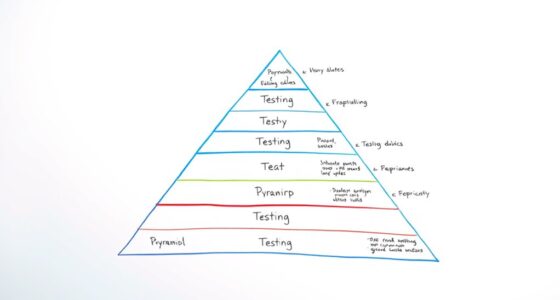You should stop testing when your automated tests show a high pass rate, typically around 95% or more, and your regression runs indicate system stability with no critical defects. Confirm you’ve met clear exit criteria based on risk assessments, such as resolving all high-priority bugs, and verify that further testing offers diminishing returns. Balancing these factors helps prevent premature release or unnecessary delays—discover more strategies to set effective exit criteria below.
Key Takeaways
- Ensure all critical and high-priority defects are resolved before considering test completion.
- Confirm automated test suites achieve predefined pass rates and coverage thresholds.
- Verify multiple successful regression runs indicating system stability and no recent bug introductions.
- Assess diminishing returns by stopping when further testing yields no new insights or risks.
- Use a combination of automated results, regression outcomes, and risk evaluation to confidently decide to stop testing.

Ever wonder how you know when to stop testing your software? It’s a common question, especially as projects grow more complex. The key lies in establishing clear exit criteria—standards that determine when testing is complete and the software is ready for release. Without these benchmarks, you risk either stopping too early and missing critical defects, or over-testing and wasting valuable resources. As you develop your testing strategy, integrating test automation and regression testing into your exit criteria can substantially improve your confidence that the software is stable and ready to go.
Test automation plays an essential role in defining when to stop testing. Automated tests can run consistently and quickly, giving you reliable data on the system’s health at any point. When your automated test suite covers the critical functionalities and passes all tests without failures, it’s a strong indicator that the core features are functioning correctly. However, automation alone doesn’t guarantee completeness. You need to set specific thresholds—such as 95% of test cases passing or a certain amount of code coverage—to decide when automation has done its job. Once these thresholds are met, and no new bugs emerge over a given period, you can confidently consider stopping further tests. Remember, automation helps accelerate regression testing, which is indispensable for catching unintended side effects after changes. If your regression test suite is stable and consistently passes, it signals that recent modifications haven’t broken existing features, another sign that testing can be wrapped up.
Automated tests and coverage thresholds help determine when testing is complete and the software is stable.
Regression testing, in particular, provides a clear marker for when to stop. When you’ve run your regression suite multiple times and observed no new defects, it’s a strong indication that the system is stable. Many teams set specific exit criteria such as “no critical or high-priority bugs open,” or “all regression tests have passed for at least two consecutive runs.” These criteria ensure you’re not merely relying on a single test pass but have confirmed stability over time. Additionally, you should consider the diminishing returns aspect—if further testing yields no new insights and the risks are low, it’s probably time to conclude testing. Furthermore, understanding the divorce process in your jurisdiction can help set realistic expectations for project deadlines and testing completeness, especially when coordinating with legal or compliance requirements.
Ultimately, the decision to stop testing hinges on a combination of automation results, regression testing outcomes, and risk assessment. Clear exit criteria help prevent premature releases or unnecessary delays. They give you a structured way to evaluate whether the software is ready, balancing thoroughness with efficiency. By setting defined benchmarks for test automation and regression testing, you can confidently move forward, knowing you’ve minimized risk and maximized quality before release.
Frequently Asked Questions
How Do Project Deadlines Influence Testing Exit Decisions?
Project deadlines play a big role in your testing exit decisions. You need to balance completing test automation and regression cycles efficiently without rushing, which could risk missing critical issues. As deadlines approach, you might reduce scope or prioritize tests, but make certain you don’t backfire by skipping essential coverage. Staying disciplined helps you determine the right point to stop testing, delivering quality on time without compromising product stability.
What Role Does User Feedback Play in Stopping Testing?
Imagine you’re waiting for user feedback to finish your testing, like waiting for a friend’s opinion before finalizing plans. User feedback plays a crucial role, serving as a real-time gauge of user satisfaction. Feedback loops help you identify issues early and decide if testing should stop or continue. If users express satisfaction and no major bugs surface, it’s a good sign you’re ready to wrap up testing confidently.
Can Testing Be Stopped Prematurely Without Risks?
You might consider stopping testing prematurely if risk assessment shows minimal risk remaining and test automation covers critical areas effectively. However, rushing can backfire, missing defects and increasing post-release issues. To avoid this, guarantee thorough automation and clear exit criteria are in place. Balancing automation with manual checks and ongoing risk assessment helps you determine the right time to stop testing without exposing your project to unnecessary risks.
How Does Team Experience Impact Exit Criteria?
While it’s tempting to see team experience as merely a factor, it subtly influences your exit criteria by shaping team dynamics and skill development. When your team has more experience, they tend to better recognize testing completeness and quality benchmarks, reducing the risk of premature termination. Conversely, less experienced teams might need more conservative criteria, ensuring thorough testing while fostering growth. Ultimately, experience helps balance confidence and caution in your testing process.
What Are the Signs of Diminishing Testing Returns?
You’ll notice diminishing testing returns when increasing test coverage no longer uncovers significant bugs, especially those of high bug severity. If you find that your efforts yield few new issues or only minor defects, it’s a sign to reassess your testing scope. Focus shifts from finding bugs to verifying fixes, ensuring your resources are well spent. This helps avoid wasted time and aligns testing efforts with project priorities.
Conclusion
So, next time you’re tempted to keep testing just “to be sure,” remember: even Sherlock Holmes would call it quits when the case gets too costly. Exit criteria aren’t just fancy metrics—they’re your sanity-savers. Stop testing before you turn your project into a never-ending saga of “just one more bug.” Trust me, nobody’s career or coffee budget survives endless testing. Know when to stop, or risk becoming the hero of your own debugging nightmare.









